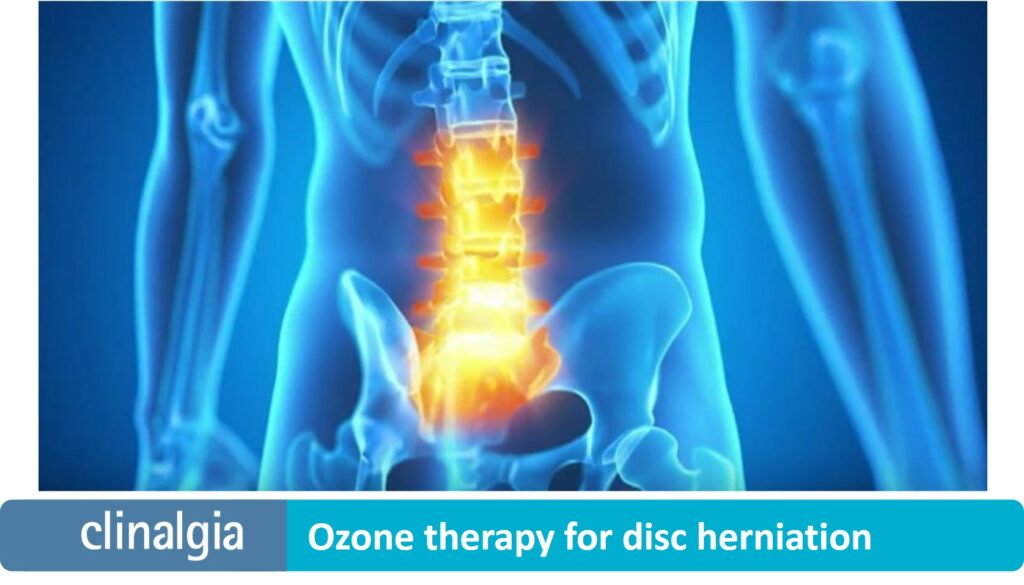
Ozone therapy for disc herniation
Ozone therapy for disc herniation
How can ozone therapy help discogenic pain?
Multiple investigations demonstrate the efficacy of ozone therapy in the treatment of disc herniation and that treated patients significantly improved pain and functional limitation.
Discogenic pain is one of the great diagnostic and therapeutic challenges for specialists in the treatment of low back pain.
Ozone discolysis has not only demonstrated its usefulness in the treatment of pure discogenic pain, but it is also an effective therapeutic alternative in the treatment of pain due to disc herniation.
Medical ozone for the treatment of chronic pain
Ozone therapy is the use of medical ozone as a treatment for diseases in which there is hypoxia, inflammation or alterations related to immunity or oxidative stress.
Although there are studies in various diseases, it is mainly used in the adjuvant treatment of chronic pain.
The pharmacology and biochemistry of ozone as a biological medicine can be studied in a consensus document published by several experts of the World Federation of Ozone Therapy.1
Ozone therapy was included by the Ministry of Health in the portfolio of services of Pain Units (public or private) in 2011.
Infiltrated ozone is useful to treat conditions such as arthritis, tendinitis, myositis, fasciitis, neuritis or myofascial pain,2 and its use is becoming increasingly widespread.
How can ozone therapy help herniated discs?
Ozone therapy in herniated discs
Cesare Verga, in the 1980s,3 was the first to describe intramuscular paravertebral and trigger point ozone applications in patients with chronic low back pain.
Subsequently, the positive results, together with the safety of the technique and the probabilities of suffering the «failed back surgery» syndrome, have led more and more authors to consider medical ozone therapy as the main option for treating low back pain.
A group of researchers, in 2003, added intradiscal and periganglionic ozone to the usual infiltration performed by applying local anesthetics and corticoids.
The results were better when medical ozone was added, which never interfered with the classic treatments.4
Mario Muto and his team effectively and safely performed tomography-guided intradiscal, periganglionic and periradicular infiltrations on 2,900 patients with disc herniation.5
Durable treatment efficacy
Mateo Bonetti and his team, in a clinical trial, compared the effectiveness of intraforaminal ozone infiltration with periradicular steroid infiltration.
Ozone was more effective in the long term, with a lower failure rate (8.6%) than steroid treatments (21.4%).6
Authors such as Torres and his team also obtain positive and long-lasting results in the treatment of sciatica due to disc herniation.7
Other research teams have demonstrated the efficacy and safety of ozone therapy in herniated discs, both in the treatment of pain and functional limitation associated with herniated and protruded discs.8-11
In 2006 another randomized clinical trial was published comparing the effectiveness of paravertebral muscular infiltration of O2/O3 with epidural steroids in patients refractory to conventional treatments (steroids and myorelaxants).
The improvement was statistically significant in favor of patients treated with ozone therapy.12
Paravertebral ozone infiltrations
Subsequently, a clinical trial demonstrated the usefulness of ozone therapy paravertebral infiltrations in disc herniation in the treatment of acute low back pain with disc herniation.
The patients treated significantly improved pain and functional limitation, and the positive results justify that this technique, which is much less invasive and much safer, is the most widely used in clinical practice.13
With the highest level of scientific evidence, two subsequent systematic reviews have demonstrated the efficacy and safety of the technique.14, 15
The use of infiltrated medical ozone in operated patients who have not obtained good results after the operation («failed back surgery») could also be of interest.16
According to the above, it is currently considered that infiltrated medical ozone, either deep paravertebral or of the trigger points of the musculature, are techniques of first choice in the treatment of lumbocatalgia, especially taking into account that the adverse effects and complications of corticoids would be avoided.17-19
Ozone in the treatment of failed back surgery syndrome
It is also clear that the administration of ozone does not close the way to surgery or worsen its prognosis.
Finally, it should be mentioned that the effectiveness of ozone therapy in the treatment of failed back surgery syndrome, which is highly prevalent among patients who have undergone spinal surgery, and which tends to worsen with surgical reentry, remains to be demonstrated.20,21
A promising alternative would be the combination of paravertebral infiltrations combined with caudal epidurals.22
References:
-
-
- WFOT: http://www.wfoot.org/wp-content/uploads/2016/01/WFOT-OZONE-2015-ESP.pdf.
- http://www.msc.es/organizacion/sns/planCalidadSNS/docs/EERR/Unidad_de_tratamiento_del_dolor.pdf
- Verga C. Nuovo approccio terapeutico alle ernie protusioni discali lombari. Riv Neuroradiol 1989; 2:1489.- Bocci V. Oxygen-Ozone Therapy. A critical evaluation. Kluwer Academic Publishers 2002; Dordrecht, The Netherlands.
- Cosma F, Simonetti L, De Santis F, Agati R, Ricci R, Leonardi M. Minimally invasive oxigen-ozone therapy for lumbar disk herniation. Am J Neurol 2003; 24:996-1000.
- Muto M, Ambrosanio G, Guarnieri G, Capobianco E, Piccolo G, Annunziata G, Rotondo A. Low back pain and sciática: treatment with intradiscal-intraforaminal O2-O3 infection. Our experience. Radiol Med 2008; 113:695-706.
- Bonetti M, Fontana A, Cotticelli B, Dalla-Volta G, Guindani M, Leonardi M. Intraforaminal O2/O3 versus periradicular steroidal infiltrations in lower back pain: randomized controlled study. Am J Neurol 2005; 26:996-1000.
- Torres LM, Terrero MJ, Vidal M, Aragón F, Martínez J. Discólisis con ozono intradiscal en el tratamiento de la ciática por hernia discal. Rev Soc Esp Dolor 2009; 16:147-152.
- Buric J, Alexandre A, Corò L, Azuelos A. Intradiscal ozone treatment of non-contained disc herniations. 18 months follow-up. Rivista Italiana di Ossigeno-Ozonoterapia 2003; 2:153-160.
- Buric J. Ozone chemyonucleolysis vs microdiscectoy. Prospective controlled study with 18 months follow-up. Rivista Italiana di Ossigeno-Ozonoterapia 2005; 4:49-54.
- Qing H, Feng D, Tao L, Hui L, Xiao Fang L, Dong L. Report on 602 cases of percutaneous ozone puncture chemonucleolysis treating lumbar disc protusion. Rivista Italiana di Ossigeno-Ozonoterapia 2005; 4:145-148.
- Castro M, Canovas L, Martínez J, Pastor A, Segado I, Rocha F, Izquierdo C. Discólisis percutánea con ozono: nuestra experiencia. Rev Soc Esp Dolor 2009; 16:405-409.
- Zambello A, Fara B, Tabaracci G, Bianchi M. Epidural steroid injection vs paravertebral O2/O3infiltration for symptomatic herniated disc refractory to conventional treatment. A prospective randomized study. Rivista Italiana di Ossigeno-Ozonoterapia 2006; 5:123-127.
- Paoloni M, Di Sante L, Caccio A, Apuzzo D, Marotta S, Razzano M, Franzini M, Santilli V. Intramuscular oxygen-ozone therapy in the treatment of acute back pain with lumbar disc herniation: a multicenter, randomized, double-blind, clinical trial of active and simulated lumbar paravertebral injection. Spine 2009; 1; 34:1337-1344.
- Stephen J, Thomas-Meaders BS, Muto M, Murphy KJ. A metaanalysis of the effectiveness and safety of ozone treatments for herniated lumbar discs. Journal of vascular and interventional radiology 2010; 21:534-548.
- Magalhaes FN, Dotta L, Sasse A, Teixera MJ, Fonoff ET. Ozone therapy as a treatment for low back pain secondary to herniated disc: a systematic review and meta-analysis of randomized controlled trials. Pain Physician. 2012;15: E115–E129.
- Gangi A, Dietemann JL, Mortazavi R, Pfleger D, Kauff C, Ray C. CT-guided interventional procederes for pain managemente in the lumbosacral spine. Radiographics 1998; 18:621-633.
- REF: Fernández AM, Povedano J, Campos S, García-López A. Eficacia clínica de las infiltraciones con esterodies Rev Esp Reumatol 1998; 25: 361-370.
- Bocci V, Borrelli E, Zanardi I, Travagli V. The usefulness of ozone treatment in spinal pain. Drug Des Devel Ther. 2015; 9:2677-2685.
- Muto M, Giurazza F, Silva RP, Guarnieri G. Rational approach, technique and selection criteria treating lumbar disk herniations by oxygen-ozone therapy. Interv Neuroradiol. 2016; 22:736-740.
- Hernández-Guinea BD, Tenopala-Villegas S, Canseco-Aguilar CP, Torres-Huerta JC. Eficacia de la aplicación de ozono epidural y paravertebral a una concentración de 30 μgr/ml para el manejo del dolor crónico en pacientes con síndrome de cirugía fallida de espalda. Rev Soc Esp Dolor 2012; 19:3-10.
- Riestra-Grijalva YM, Hernández-Sántos JR, Tenopala-Villegas S, Canseco-Aguilar CP, Torres-Huerta JC. Eficacia de la aplicación de ozono epidural y paravertebral a una concentración de 50 μgr/ml en pacientes con dolor crónico secundario a síndrome postlaminectomía. Rev Soc Esp Dolor 2012; 19:66-71.
- Padilla del Rey ML, García Fernández MR, García Sánchez F, Rastrollo Peña D, Díaz-Alejo Marchante C, Gonzálvez Ortega JJ, Hidalgo Tallón FJ. Ozonoterapia en el síndrome de cirugía fallida de espalda. 21ª Reunión Anual ESRA-ESPAÑA.
-



